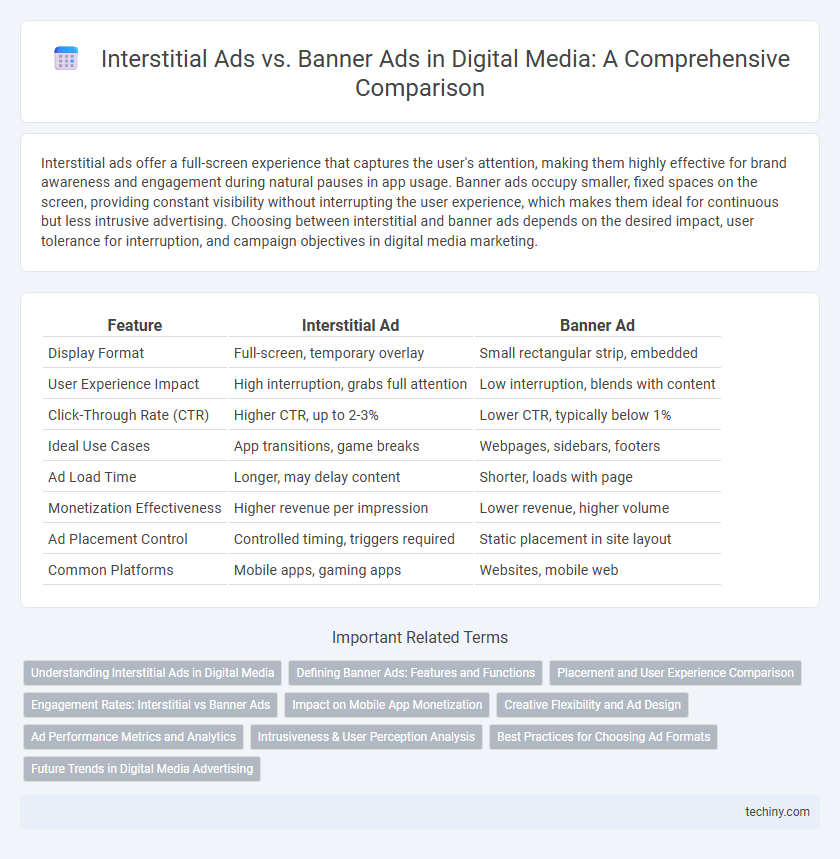Interstitial ads offer a full-screen experience that captures the user's attention, making them highly effective for brand awareness and engagement during natural pauses in app usage. Banner ads occupy smaller, fixed spaces on the screen, providing constant visibility without interrupting the user experience, which makes them ideal for continuous but less intrusive advertising. Choosing between interstitial and banner ads depends on the desired impact, user tolerance for interruption, and campaign objectives in digital media marketing.
Table of Comparison
| Feature | Interstitial Ad | Banner Ad |
|---|---|---|
| Display Format | Full-screen, temporary overlay | Small rectangular strip, embedded |
| User Experience Impact | High interruption, grabs full attention | Low interruption, blends with content |
| Click-Through Rate (CTR) | Higher CTR, up to 2-3% | Lower CTR, typically below 1% |
| Ideal Use Cases | App transitions, game breaks | Webpages, sidebars, footers |
| Ad Load Time | Longer, may delay content | Shorter, loads with page |
| Monetization Effectiveness | Higher revenue per impression | Lower revenue, higher volume |
| Ad Placement Control | Controlled timing, triggers required | Static placement in site layout |
| Common Platforms | Mobile apps, gaming apps | Websites, mobile web |
Understanding Interstitial Ads in Digital Media
Interstitial ads in digital media are full-screen advertisements that appear at natural transition points, such as between content pages or during app loading times, ensuring higher user engagement compared to traditional banner ads. These ads offer immersive visual experiences, maximizing brand recall and click-through rates by temporarily capturing users' full attention. Unlike banner ads, interstitials can incorporate rich media elements like video and interactive features, enhancing the effectiveness of digital advertising campaigns.
Defining Banner Ads: Features and Functions
Banner ads are rectangular graphic advertisements embedded on web pages, designed to attract user attention through visuals and brief messaging. Common sizes include leaderboard (728x90), medium rectangle (300x250), and skyscraper (160x600), optimizing placement across desktop and mobile platforms. These ads function by driving traffic to advertiser websites, maximizing brand visibility with clickable elements and targeting options such as demographic and behavioral data.
Placement and User Experience Comparison
Interstitial ads appear as full-screen overlays typically during natural transition points, offering high visibility but potentially disrupting user experience. Banner ads are embedded within content or at screen edges, providing a less intrusive presence that maintains continuous engagement. Effective ad placement balances visibility with user experience, optimizing both ad impressions and retention rates in digital media campaigns.
Engagement Rates: Interstitial vs Banner Ads
Interstitial ads generate significantly higher engagement rates compared to banner ads due to their full-screen format that captures user attention more effectively. Banner ads typically have lower click-through rates because of their smaller size and less intrusive placement. Studies show interstitial ads can achieve engagement rates up to 4 times greater than standard banner ads.
Impact on Mobile App Monetization
Interstitial ads generate higher engagement and revenue in mobile app monetization due to their fullscreen format that captures users' full attention, leading to increased click-through rates compared to banner ads. Banner ads, while less intrusive and maintaining user experience, typically yield lower eCPM and click rates but can be effective for continuous brand visibility within apps. Optimizing ad placement and frequency for both interstitial and banner ads is crucial to balance monetization goals with user retention on mobile platforms.
Creative Flexibility and Ad Design
Interstitial ads offer greater creative flexibility by utilizing full-screen formats that allow immersive visuals, rich media, and interactive elements, enhancing user engagement. Banner ads are constrained by fixed sizes and placements, limiting design innovation but enabling consistent brand presence within web page layouts. Effective ad strategies leverage interstitials for impactful storytelling while using banners for persistent visibility and brand reinforcement.
Ad Performance Metrics and Analytics
Interstitial ads typically yield higher click-through rates (CTR) and engagement due to their full-screen format interrupting user activity, making them more effective for brand awareness and conversions. Banner ads, while less intrusive, generally display lower CTR but offer consistent impressions and better frequency control, making them suitable for sustained visibility and retargeting strategies. Analyzing metrics such as CTR, conversion rates, viewability, and bounce rate provides crucial insights to optimize ad spend and improve overall campaign effectiveness across these ad formats.
Intrusiveness & User Perception Analysis
Interstitial ads are highly intrusive due to their full-screen format that disrupts user interaction, often leading to negative user perception and increased ad avoidance. Banner ads, while less disruptive by occupying smaller screen areas, typically suffer from lower visibility and engagement rates but are perceived as less invasive. User experience studies indicate that minimal intrusion in ad formats correlates with improved brand recall and reduced ad fatigue, emphasizing the importance of balancing ad impact with user acceptance.
Best Practices for Choosing Ad Formats
Interstitial ads offer high visibility by occupying the full screen, making them ideal for high-impact campaigns and driving strong user engagement. Banner ads work best for continuous brand presence and subtle promotion without disrupting user experience, often placed at screen edges or within content. Choosing between interstitial and banner ads depends on campaign goals, user tolerance for interruption, and the desired balance between engagement and seamless browsing.
Future Trends in Digital Media Advertising
Future trends in digital media advertising highlight the growing preference for interstitial ads over traditional banner ads due to their higher engagement rates and immersive user experience. Advanced technologies like AI and programmatic advertising will enable more personalized and contextually relevant interstitial campaigns, driving improved ROI for advertisers. Enhanced mobile optimization and seamless integration with video content will further solidify interstitial ads as a dominant format in the evolving digital advertising ecosystem.
Interstitial Ad vs Banner Ad Infographic

 techiny.com
techiny.com